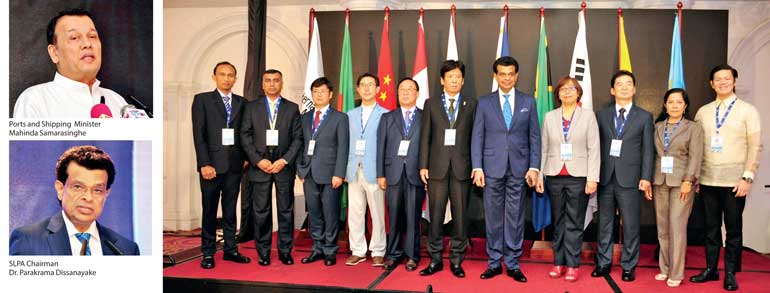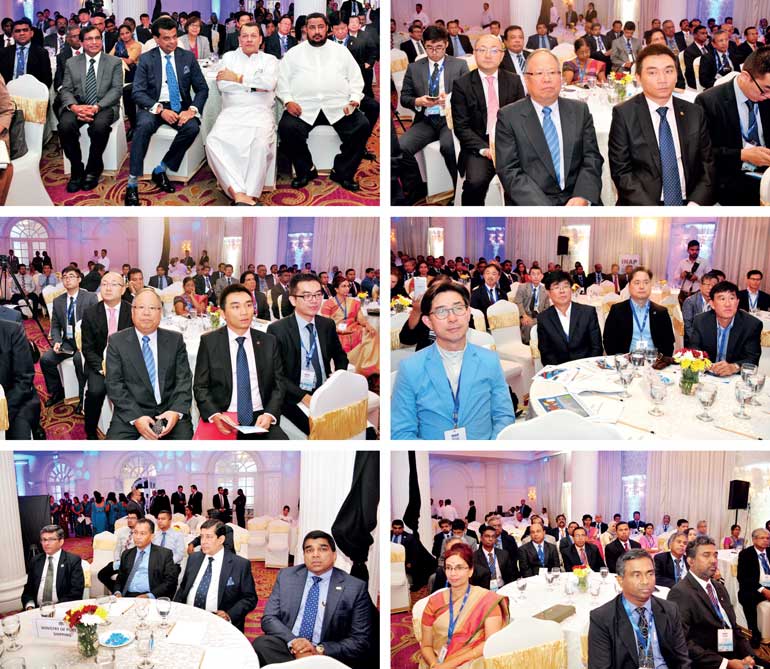Saturday Apr 27, 2024
Saturday Apr 27, 2024
Thursday, 9 November 2017 00:00 - - {{hitsCtrl.values.hits}}



By Himal Kotelawala
Ports and shipping Minister Mahinda Samarasinghe yesterday reiterated the Government’s earlier assurance that any foreign military activity at the strategically located Hambantota Port will be decided through a mutually established government-to-government (G2G) agreement.
The terminal operator or the services operator will not be deciding on military activity centred around the Port, which he said was a 100% commercial investment.
Speaking at the 19th conference on International Network of Affiliated Ports (INAP), the Minister said that Sri Lanka’s foreign policy was to get along with all nations and thus does not wish to be embroiled in a geopolitical conflict.
Any country that wishes to use the Hambantota Port to bring in a naval ship, to engage with the Sri Lanka Navy, or engage in naval exercises, said Samarasingne, may do so once a G2G agreement has been reached to that effect.
“It’s a 100% commercial investment. It has no politics; it has no military agenda. We are investing in the Port with a huge amount of money because we feel it’s a commercially viable investment. We have put in all the safeguards necessary to ensure that the right signals are sent to all those [countries] watching each other. We don’t want to be sandwiched in a geopolitical conflict,” he said.
The Sri Lankan Government has nothing to hide as far as the agreement between the Sri Lanka Ports Authority (SLPA) and the China Merchant Port company is concerned, said the Minister, adding that it’s a Cabinet-approved public document that is no longer objected to by its former critics.
“Those who thought there were hidden objectives are satisfied with the checks and balances put in place to ensure that their interests will not be compromised,” he said.
“Our foreign policy is to get along with everyone. We have no favourites. We will facilitate anyone in the interest of Sri Lanka to come and enjoy the facilities we have in the seven ports the SLPA manages,” he said.
The Minister invited the international delegates present at the conference to visit Sri Lankan ports, noting that the participating countries could benefit from sharing insights, training opportunities, etc. with each other by way of port visits and by facilitating comparative advantage.
Samarasinghe also spoke of stability in Sri Lanka.
“For economic prosperity, political stability is a sine quo non. Today we have a Government that includes the two major political parties in Sri Lanka. We enjoy two-thirds of our Parliament. There is a Constitution reform process. Our Government respects the fact that Sri Lanka is a multicultural, multilingual, multi-religious, multiethnic society. We want to strengthen and nurture this diversity,” he said, noting that ensuring the country did not return to a long-drawn war was crucial.
“We’re coming together to ensure comprehensive reconciliation nine years after the end of the war. Economic prosperity and sustainable development are dependent on ensuring that this diversity is protected and nurtured and every Sri Lankan feels they enjoy equal benefits emanating from our laws and our Constitution,” said Samarasinghe.
Touching on the history of the SLPA, the Minister said that despite the downward trend of the country’s economic momentum due to terrorism from 1983, the opening of the economy in 1978 resulted in increased employment creation and income generation as well as accelerated development and economic growth due to the export-led growth strategy adopted by the administration.
The first country in South Asia to adopt a free enterprise model, Sri Lanka paved the way for other nations in the region to open their economies. Part of the resultant economic development, said the Minister, was the investment put in place to develop the Colombo Port and other ports that come under the SLPA.
An accelerated development program launched in the late 1970s, he said, has today resulted in the Colombo Port being ranked no. 23 in the world.
“We’re not satisfied with this position. During my period of office I want to take it to the top 10. We have put in place various strategies and development plans which would increase our infrastructure facilities, in turn increasing productivity in our ports,” said Samarasinghe.
Plans are underway to develop brand new ports, said the Minister, adding that the Government wishes to work with the private sector in this regard.
“[We wish to work with] not only the foreign partners we’re working with at the moment but also the private sector in Sri Lanka, which is very dynamic. The Government has identified the private sector as the main engine of growth. We have confidence in their talents and dedication to partner us in an accelerated growth which would bring the Colombo Port into the top 10, rather than being satisfied with number 23,” he said.
One of the major development programs launched by Sri Lanka in the recent past, he said, was the partnership put in place between China Merchant Port, the second largest port operator in the world, and the SLPA.
“Ten years ago, the then Government decided to invest $ 1.5 billion to develop the Hambantota Port. It was not a location picked out of a hat. It was picked out many years before the decision was taken to develop this port [through scientific study],” said the Minister, adding that experts had concluded the location was “excellent” for maritime activity and business related ventures.
“About 10 years ago, a loan was negotiated through China Exim Bank. $ 1.5 billion was spent on the first and second phases of the Port, resulting in the basic infrastructure being put in place but not a fully operational port.
“When the new Government came into power, we were straddled with this huge debt. The grace period was running out and we had to pay the loan. The SLPA was the party on our side and they had to service the loan. The SLPA is a self sustainable organisation; they don’t receive a rupee from the Treasury. It’s a profit making government organisation that finances their entire operation. They had to undertake paying back this huge loan. The payments were as much as the profit that the SLPA was making at the time. By 2022, we found, the loan service would eat up all the profits it would generate. We had to take a decision to get out of this debt trap,” said the Minister.
He then went on to explain the formulation of the agreement between the SLPA and CM Port, which led to a 70-30 model where Sri Lanka received $ 1.4 billion for 70% of the Hambantota Port operation, with the SLPA holding 30% of the equity.
“The handover will take place in the first week of December. 40% of this money will come into the coffers of the Treasury, which will boost international reserves and stabalise the rupee. It will instill confidence in others to bring in FDI to Sri Lanka because the economic fundamentals would be in place,” he said.
Under the very strong SLPA law in Sri Lanka, Port services cannot be given out to anyone. Terminal services can be given out to a PPP partner.
“We have two such models working very well in the Colombo Port: The CICT and the consortium of private sector companies including international companies that come together in the SAGT terminal.”
Ports services cannot be given out to anyone other than the SLPA, reiterated the Minister.
“We have to be innovative in designing a model, on the hand to ensure the law will not be violated and on the other hand to instill confidence in our partner, to ensure that this 99-year lease will not disadvantage them in the future.
“It takes two to tango. Both parties have to be working together to ensure a successful partnership at the end of it. It has to be a win-win situation. No one will put in $ 1.4 billion unless their investment can be made secure,” he said.
With the active participation of CM Port, he went on to say, a model was arrived at that resulted in two Sri Lankan companies being formed; one that would run the terminal operations where the equity partnership would be 85% to CM Port, and SLPA holding 15%; not unlike the arrangement in the Colombo Port.
The second company, called Hambantota International Port Services, (HIPS), headed by the present SLPA Chairman, will take all decisions in relation to port services.
“It took many weeks to negotiate this. From the very outset, CM Port respected the fact that they had to operate within the laws of Sri Lanka,” said the Minister.
- Pix by Lasantha Kumara